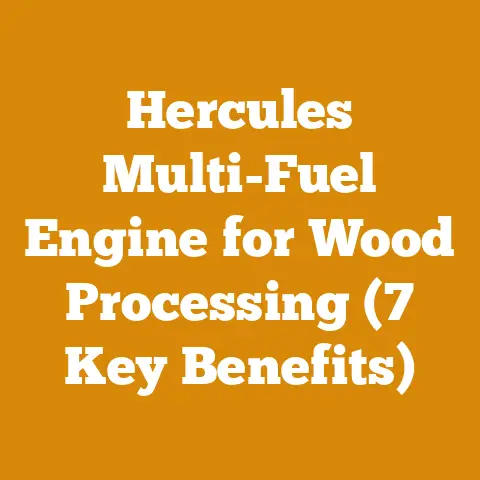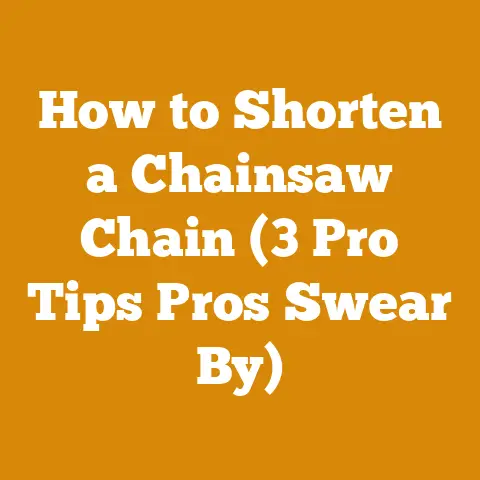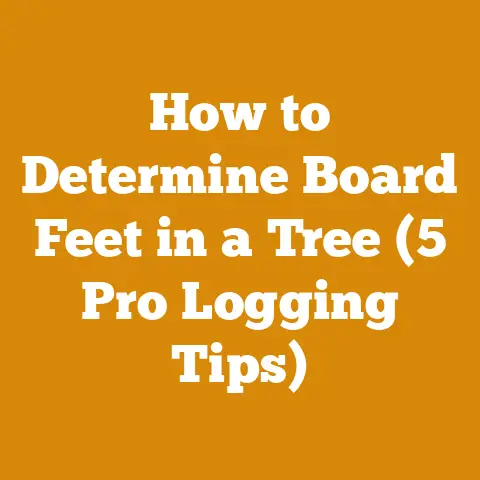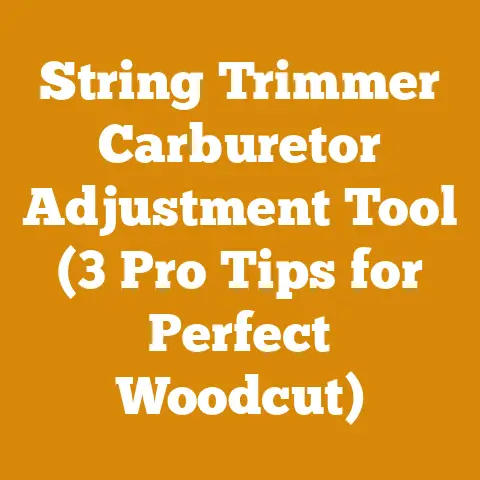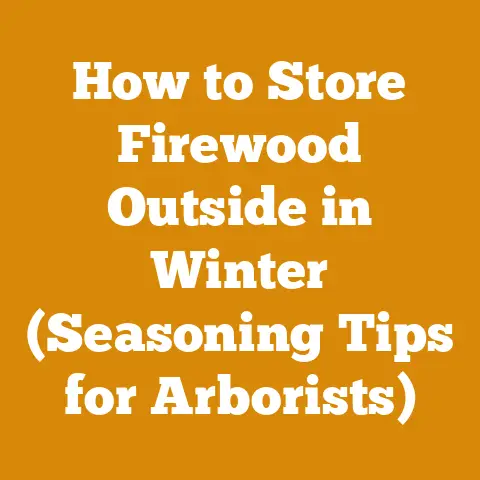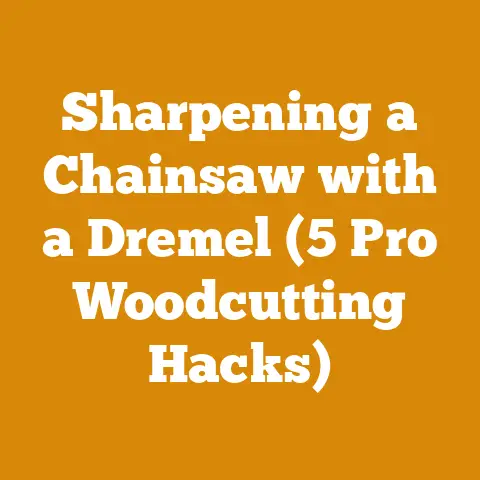How Much to Grind a Stump (5 Pro Tips for Accurate Pricing)
Have you ever stared at a stubborn tree stump in your yard, wondering how much it would cost to banish it from existence?
Stump grinding is a common task, but pricing it accurately can be tricky.
As someone who’s spent years felling trees, processing wood, and even wrestling a few stumps myself, I’ve learned that there’s more to it than just guessing.
I’m going to share my insights and give you five professional tips for nailing your stump grinding prices.
Understanding Stump Grinding and Its Importance
Before we dive into pricing, let’s make sure we’re all on the same page.
Stump grinding involves using a specialized machine – a stump grinder – to chip away at a tree stump until it’s below ground level.
This is different from stump removal, which involves digging out the entire stump and root system.
Why is stump grinding important?
- Aesthetics: Let’s face it, stumps aren’t pretty.
They can ruin the look of a well-manicured lawn. - Safety: Stumps can be tripping hazards, especially for kids playing in the yard.
- Pest Control: Decaying stumps can attract insects like termites and ants, which can then infest your home.
- Land Use: Stumps prevent you from using the land for other purposes, such as planting a garden or building a shed.
- Disease Prevention: Some tree diseases can linger in the stump and spread to other healthy trees.
Key Terms and Concepts
- Stump Grinder: A machine with a rotating cutting wheel equipped with teeth designed to grind wood.
Different sizes exist for different stump sizes and terrains. - Grinding Depth: How far below ground level the stump is ground.
Typically, this is 4-6 inches, but it can vary. - Diameter at Breast Height (DBH): A standard measurement of tree trunk diameter taken at 4.5 feet above ground level.
This is often used to estimate the size of the stump. - Access: How easily the stump grinder can reach the stump.
Obstacles like fences, trees, or steep slopes can affect access and increase the price. - Root System: The network of roots extending from the stump.
While the stump grinder focuses on the visible stump, the root system can still be a factor in pricing, especially if large surface roots need to be addressed. - Clean-up: The process of removing wood chips and debris after the stump grinding is complete.
This can be included in the price or charged separately.
Tip #1: Accurately Assess the Stump (and Its Surroundings)
The first step in pricing any stump grinding job is to thoroughly assess the stump itself and the surrounding area.
Don’t just eyeball it!
Get specific measurements and take detailed notes.
Measuring the Stump
- Diameter: Measure the diameter of the stump at its widest point.
This is the single most important factor in determining the price.
I always take multiple measurements and average them to get the most accurate diameter. - Height: Measure the height of the stump above ground level.
A taller stump will require more grinding and therefore cost more. - Number of Stumps: Are you grinding one stump or multiple?
Obviously, more stumps mean more work.
Assessing the Surroundings
- Access: Can you easily get the stump grinder to the stump?
Are there fences, gates, or other obstacles in the way?
A stump that’s difficult to access will require more time and effort, and that needs to be reflected in the price.
I once had a job where I had to maneuver a stump grinder through a narrow gate and up a steep hill – it took twice as long as I expected! - Underground Utilities: Always, always check for underground utilities before grinding.
Call 811 (in the US) to have the utilities marked.
Hitting a gas line or electrical cable can be disastrous (and expensive!). - Obstacles: Are there rocks, roots, or other obstacles around the stump that could damage the stump grinder?
These obstacles need to be removed before grinding, and that can add to the cost. - Soil Type: The type of soil can affect the grinding process.
Sandy soil is easier to grind than clay soil, which can be very hard and abrasive. - Proximity to Structures: How close is the stump to buildings, fences, or other structures?
You’ll need to be extra careful to avoid damaging these structures, and that can slow you down. - Root Flare: Observe how far the root flare extends from the stump.
A wide root flare indicates a larger, more complex root system which will take more time to grind.
Example: Stump Assessment
Let’s say you’re assessing a stump and find the following:
- Diameter: 24 inches
- Height: 12 inches
- Access: Easy access, no obstacles
- Underground Utilities: Marked and clear
- Soil Type: Sandy loam
- Proximity to Structures: 10 feet from a fence
This stump would be relatively easy to grind and should be priced accordingly.
Tip #2: Know Your Equipment (and Its Capabilities)
The type of stump grinder you use will have a significant impact on the price you charge.
There are different types of stump grinders, each with its own capabilities and limitations.
Types of Stump Grinders
- Handheld Stump Grinders: These are small, lightweight machines that are good for grinding small stumps and roots.
They’re relatively inexpensive, but they’re not very powerful and can be tiring to use for extended periods. - Walk-Behind Stump Grinders: These are larger and more powerful than handheld grinders.
They’re good for grinding medium-sized stumps and are easier to maneuver than tow-behind grinders. - Tow-Behind Stump Grinders: These are the largest and most powerful stump grinders.
They’re designed for grinding large stumps and are typically towed behind a truck or tractor. - Self-Propelled Stump Grinders: These are similar to walk-behind grinders but have their own engine to drive the wheels, making them easier to maneuver on uneven terrain.
- Hydraulic Stump Grinders: These grinders use hydraulic power to drive the cutting wheel, providing more power and torque than gas-powered grinders.
They are often found on skid steers or excavators.
Stump Grinder Specifications
When choosing a stump grinder, consider the following specifications:
- Engine Horsepower: Higher horsepower means more power and faster grinding.
- Cutting Wheel Diameter: A larger cutting wheel can grind larger stumps more efficiently.
- Cutting Depth: The maximum depth the grinder can grind below ground level.
- Cutting Height: The maximum height the grinder can grind above ground level.
- Weight: A heavier grinder will be more stable and less likely to bounce around, but it will also be harder to maneuver.
- Tooth Type: Different tooth types are designed for different types of wood and soil.
Carbide-tipped teeth are the most durable and can handle rocks and other debris.
Matching Equipment to the Job
It’s crucial to match the right equipment to the job.
Using a small handheld grinder on a large stump will be slow, inefficient, and hard on the machine.
Conversely, using a tow-behind grinder on a small stump is overkill and will waste fuel and time.
For example, I once tried to grind a 36-inch oak stump with a small walk-behind grinder.
It took me almost a full day, and the grinder was struggling the whole time.
I learned my lesson!
Now, I always use a tow-behind grinder for stumps that size.
Maintenance Costs
Don’t forget to factor in the cost of maintaining your stump grinder. This includes:
- Tooth Replacement: Stump grinder teeth wear down quickly and need to be replaced regularly.
- Oil Changes: Keep the engine properly lubricated.
- Air Filter Cleaning: A clean air filter ensures proper engine performance.
- Belt Replacement: Belts can wear out and break, especially under heavy use.
- Repairs: Expect to have to repair your stump grinder from time to time.
Tip #3: Research Local Market Rates
Pricing your stump grinding services too high will scare away customers, while pricing them too low will leave you shortchanged.
The key is to find a balance that’s fair to both you and your clients.
Factors Affecting Local Rates
- Location: Prices vary widely depending on your geographic location.
Stump grinding in a major metropolitan area will typically cost more than in a rural area. - Competition: If there are many stump grinding companies in your area, you’ll need to be competitive with your pricing.
- Demand: If there’s a high demand for stump grinding services, you can charge a higher price.
- Season: Stump grinding is often more in demand during the spring and fall, so you may be able to charge more during those seasons.
- Local Economy: The overall state of the local economy can affect pricing.
In a strong economy, people are more willing to spend money on services like stump grinding.
Methods for Researching Rates
- Online Research: Search online for stump grinding companies in your area and compare their prices.
Look at websites like Yelp, Angie’s List, and HomeAdvisor. - Call Around: Call several stump grinding companies and ask for quotes.
Be sure to provide them with the same information about the stump (diameter, height, access, etc.) so you can get an accurate comparison. - Check with Landscapers and Tree Services: Landscapers and tree services often subcontract stump grinding work, so they may be able to give you an idea of the going rates in your area.
- Ask Around: Talk to friends, neighbors, and colleagues who have had stump grinding done recently and ask them how much they paid.
- Check Classified Ads: Look in local classified ads (both online and in print) for stump grinding services.
Pricing Models
There are several different pricing models commonly used for stump grinding:
- Per-Inch Pricing: This is the most common pricing model.
You charge a set price per inch of stump diameter.
For example, you might charge $3-$10 per inch. - Hourly Pricing: You charge an hourly rate for your time.
This is a good option for jobs that are difficult to estimate or that involve a lot of extra work. - Flat Rate Pricing: You charge a flat rate for the entire job.
This is a good option for simple jobs where you can accurately estimate the time and effort involved. - Minimum Charge: Many companies have a minimum charge, regardless of the size of the stump.
This is to cover the cost of travel and setup.
Example: Market Research
Let’s say you research local rates and find the following:
- Average price per inch: $5
- Hourly rate: $100
- Minimum charge: $150
You can use this information to develop your own pricing strategy.
Tip #4: Calculate Your Costs
Knowing your costs is essential for setting profitable prices.
You need to factor in all of your expenses, both fixed and variable.
Fixed Costs
Fixed costs are expenses that don’t change regardless of how much work you do.
These include:
- Equipment Payments: If you financed your stump grinder, you’ll have monthly payments to make.
- Insurance: You need to have liability insurance to protect yourself in case of accidents.
- Vehicle Registration and Insurance: If you use a truck or trailer to transport your stump grinder, you’ll have vehicle registration and insurance costs.
- Advertising and Marketing: You’ll need to spend money on advertising and marketing to attract customers.
- Rent or Mortgage: If you have a shop or office, you’ll have rent or mortgage payments to make.
- Licenses and Permits: You may need to obtain licenses or permits to operate a stump grinding business.
Variable Costs
Variable costs are expenses that change depending on how much work you do.
These include:
- Fuel: Fuel costs can be significant, especially if you’re traveling long distances.
- Tooth Replacement: Stump grinder teeth wear down quickly and need to be replaced regularly.
- Oil and Lubricants: You’ll need to buy oil and lubricants for your stump grinder.
- Repairs: You’ll need to budget for repairs to your stump grinder.
- Labor: If you hire employees, you’ll need to pay their wages and benefits.
- Disposal Fees: You may need to pay disposal fees for wood chips and debris.
- Travel Time: Consider the cost of your time traveling to and from job sites.
Calculating Your Break-Even Point
Your break-even point is the point at which your revenue equals your costs.
To calculate your break-even point, you’ll need to add up all of your fixed and variable costs and then divide by the number of jobs you expect to do.
Example:
- Fixed Costs: $5,000 per month
- Variable Costs: $50 per job
- Expected Jobs: 100 per month
Break-Even Point = ($5,000 + ($50 x 100)) / 100 = $100 per job
This means you need to charge at least $100 per job to cover your costs.
Adding a Profit Margin
Once you’ve calculated your break-even point, you need to add a profit margin to ensure that you’re making a profit.
A typical profit margin for stump grinding is 20-30%.
Example:
- Break-Even Point: $100 per job
- Profit Margin: 25%
Price = $100 x 1.25 = $125 per job
This means you should charge at least $125 per job to cover your costs and make a profit.
Tip #5: Factor in Additional Services and Considerations
Stump grinding is often just one part of a larger landscaping or tree removal project.
Offering additional services can increase your revenue and make you more competitive.
Additional Services
- Stump Removal: As mentioned earlier, stump removal involves digging out the entire stump and root system.
This is more labor-intensive than stump grinding and should be priced accordingly. - Root Removal: If the customer wants to remove the entire root system, you’ll need to use a backhoe or other heavy equipment.
- Wood Chip Removal: Some customers may want you to remove the wood chips after grinding.
This can be done with a wheelbarrow, skid steer, or dump truck. - Topsoil and Seeding: After grinding, you can fill the hole with topsoil and seed it to restore the area to its original condition.
- Planting: You can plant a new tree or shrub in the area where the stump was removed.
- Landscaping: You can offer additional landscaping services, such as mulching, edging, and planting flowers.
- Debris Hauling: You can offer to haul away other yard waste or debris.
- Lot Clearing: If the customer wants to clear an entire lot of trees and stumps, you can offer this service.
- Log Splitting: If you have the equipment, you can offer to split logs for firewood.
- Firewood Sales: You can sell the firewood that you split.
Other Considerations
- Travel Time: Factor in the cost of travel time to and from the job site.
You may want to charge a travel fee for jobs that are far away. - Minimum Charge: As mentioned earlier, many companies have a minimum charge, regardless of the size of the stump.
- Emergency Service: If you offer emergency stump grinding services (e.g., after a storm), you can charge a premium.
- Insurance: Make sure you have adequate insurance coverage to protect yourself in case of accidents.
- Payment Terms: Clearly state your payment terms (e.g., cash, check, credit card) and when payment is due.
- Warranty: Consider offering a warranty on your work.
This can give customers peace of mind and make you more competitive. - Contracts: For larger jobs, it’s a good idea to have a written contract that outlines the scope of work, price, payment terms, and warranty.
Case Study: Combining Services
I once had a customer who wanted me to grind three stumps in their backyard.
After talking to them, I learned that they also wanted to plant a garden in the area.
I offered them a package deal that included stump grinding, root removal, topsoil delivery, and planting.
They were thrilled with the convenience of having everything done by one company, and I was able to earn more revenue than I would have if I had just ground the stumps.
Putting It All Together: An Example
Let’s say you’re pricing a stump grinding job for a 20-inch oak stump.
- Assessment:
- Diameter: 20 inches
- Height: 6 inches
- Access: Easy access, no obstacles
- Underground Utilities: Marked and clear
- Soil Type: Sandy loam
- Proximity to Structures: 15 feet from a house
- Equipment: You’ll use a walk-behind stump grinder.
- Market Research: The average price per inch in your area is $6.
- Costs: Your break-even point is $100 per job, and you want to make a 25% profit margin.
- Additional Services: The customer also wants you to remove the wood chips and fill the hole with topsoil.
Pricing:
- Stump Grinding: 20 inches x $6/inch = $120
- Wood Chip Removal: $30
- Topsoil: $50
- Total Price: $200
This price is in line with market rates and will cover your costs while allowing you to make a profit.
Strategic Insights and Final Thoughts
Pricing stump grinding jobs accurately is a crucial skill for any wood processing or tree service professional.
By following these five tips, you can ensure that you’re charging fair prices that reflect the true cost of your work.
Strategic Insights:
- Build Relationships: Develop strong relationships with your suppliers (e.g., equipment dealers, topsoil providers) to get better prices and service.
- Invest in Training: Invest in training for yourself and your employees to improve your skills and efficiency.
- Stay Up-to-Date: Stay up-to-date on the latest equipment and techniques in the stump grinding industry.
- Network: Network with other professionals in the industry to share ideas and learn from each other.
- Provide Excellent Customer Service: Providing excellent customer service is essential for building a good reputation and getting repeat business.
Final Thoughts:
Stump grinding can be a challenging but rewarding profession.
By understanding the principles of pricing and providing excellent service, you can build a successful and profitable business.
Remember to always prioritize safety and follow all applicable regulations.
Now, go out there and conquer those stumps! Good luck!

